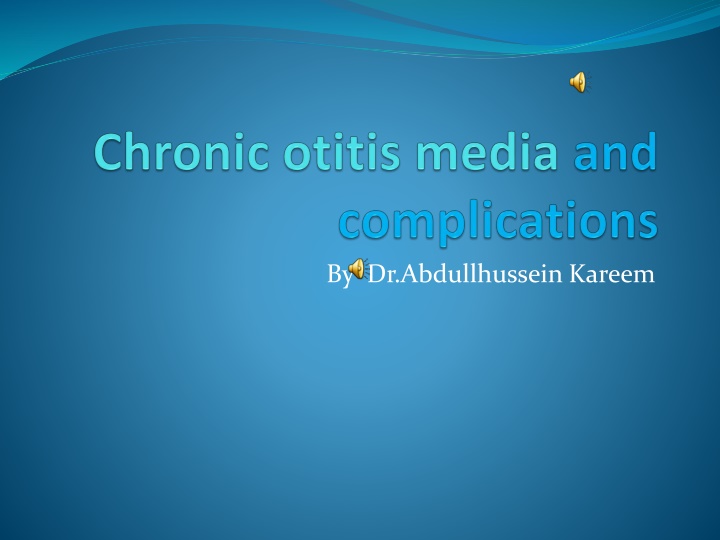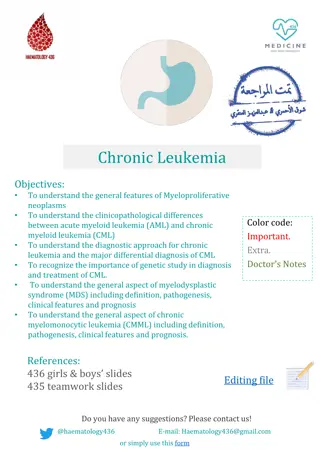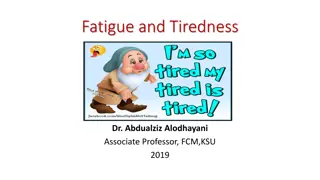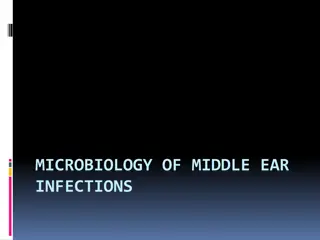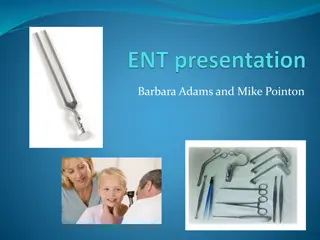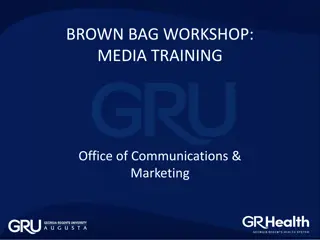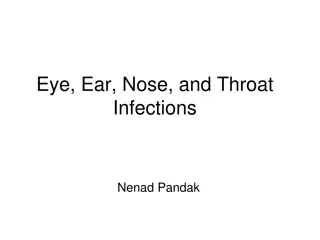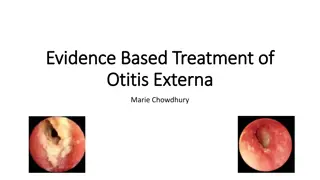Chronic Otitis Media: Classification, Causes, and Management
Chronic otitis media is a persistent inflammation of the middle ear mucosa and mastoid process for more than 3 months. It can be classified as tubotympanic or attico-antral, with the new classification including inactive and active mucosal and squamous types. The condition is influenced by factors like environment, Eustachian tube dysfunction, and microbiological agents. Common presentations include hearing impairment and otorrhea. Treatment may involve regular follow-up, ear protection, hearing aids, or surgical intervention.
Download Presentation

Please find below an Image/Link to download the presentation.
The content on the website is provided AS IS for your information and personal use only. It may not be sold, licensed, or shared on other websites without obtaining consent from the author.If you encounter any issues during the download, it is possible that the publisher has removed the file from their server.
You are allowed to download the files provided on this website for personal or commercial use, subject to the condition that they are used lawfully. All files are the property of their respective owners.
The content on the website is provided AS IS for your information and personal use only. It may not be sold, licensed, or shared on other websites without obtaining consent from the author.
E N D
Presentation Transcript
COM it is persistent inflammation of the middle ear mucosa and \or mastoid process for more than 3 months and can be classified into the followings. The old classification 1.Tubotympanic; here the tympanic membrane perforation is central (surrounded by a remnant of the tympanic membrane)located in the pars tensa,it is regarded as a safe type with less possibility of complications. 2. Attico antral ; the perforation is marginal ,situated in the pars flaccida with high possibility of complications whether intra or extra cranial.
The new classification as follows. 1.Inactive mucosal com. 2.Inactive squamous com. 3.Active mucosal com. Active squmous com. Aetiology of com. 1.Acute otitis media and otitis media with effusion. 2.Genetics and race more common in developing countries.
3.Environment; com is more common in lower socioeconomic groups, maternal smoking and day care attendance . 4.Eustachian tube dysfunction and upper respiratory tract infections. 5.Gastro-esophageal reflux disease(GERD). 6.Craniofacial abnormalities ,com is more common in cleft palate patients because tensor veli palatine muscle is hypoplastic and may predispose to Eustachian tube dysfunction.
Microbiology. 1.Pseudomonas aeruginosa. 2.Staphylococcus aureus. 3.Proteus. 4.Coliform bacilli. 5.Anaerobics. 1.Inactive mucosal com(dry perforation). There is permanent perforation of the pars tensa but the middle ear and mastoid are not inflamed ,however the hearing is impaired ,there is no active infection or mucoid discharge ,such an ear may remain inactive ,become active or heal.
Presentation. 1.Hearing impairment. 2.Incidental finding in older patients with a mixed hearing loss during routine ENT examination. 3.Otorrhea small amount and not offensive . 4.Ear discomfort during swimming . Examination. By otoscope ,endoscope or microscope to detect the site and size of perforation.
Hearing assesment . By tunning-fork and PTA the latter can detect the type of hearing loss ,air-bone gap and severity. Management. 1.No treatment ,regular follow-up and ear protection from water by using ear plugs. 2.Hearing aids for hearing impairment. 3.Surgery ,the aim of surgery is to close the perforation and improve hearing.
A.Myringoplasty it is operation of closing the tympanic membrane perforation by using graft like temporalis fascia ,perichondrium or cartilage (tragal or conchal). B.Ossiculoplastywhich is reconstruction of the ossicles by using prosthesis or autologous incus or head of malleus.
2.Active mucosal com. This type may remain active ,become inactive or progress to complications. Continuing activity may be the result of infection with a virulent or persistent organisms commonly Pseudomonas or may be due to impaired immunity as in diabetics. It may be associated with the development of granulation tissue or even aural polyp and eventually ossicular chain damage and inner ear involvement. Presentation.
1.Hearing loss, usuallyconductive in type and the severity depends on the site and size of perforation in addition to the degree of ossicular chain damage but could be sensorineural due to inner ear involvement or associated presbycusis. 2.Otorrhea ,the discharge may be continuous or intermittent, mucoid or purulent, it increases in cases of upper respiratory tract infections or water entry during swimming.
Examination - Otoscope ,endoscope or microscope. -Hearing assessment by tunning-fork and PTA. -Swab for culture and sensitivity. -CT scan and MRI to detect the pathology in the middle ear and mastoid process and to exclude intracranial complication. Management. 1.Aural toilet which is suction of the pus under microscope ,this allows accurate assessment of the ear pathology.
2.Topical medication, topical antibiotics are more effective than oral or parenteral antibiotics and may be combined with topical steroids ,the latter decrease the edema and deal with granulation tissue like gentamycin.neomycin.ciprofloacin,ofloxacin drops and dexamethasone drops. 3.Surgery ,it is indicated in cases of failure of medical treatment. A.Myringoplasty. B.Cortical mastoidectomy.
Cortical mastoidectomy (Schwartz operation) it is done under GA with cleaning of diseased cells in the mastoid process and cleaning of the middle ear to ensure good ventilation of the middle ear cleft and prevent the recurrence of the disease ,the procedure may be combined with myringoplasty. C.Aural polypectomy ,may be done under local or general anesthesia and should be sent for histopathological study in suspected cases .
3.Inactive squamous com(retraction pocket). It is defined as retraction of the pars tensa or pars flaccida with the potential to be active with retained debris(cholesteatoma).There may be associated damage to the ossicular chain and other middle ear Structures. It may resolve ,remain static or progress to cholesteatoma. The most important point is whether the pocket self cleaning or not i.e. the debris in the pocket come out the pocket or retain.
Examination. Careful examination of the ear under microscope to detect the site of pocket and photographs should be obtained for follow-up and comparison in the next examinations. Hearing assessment by tunning-fork PTA and tympanometry .the latter is very important in detection of tympanic membrane mobility. Presentation. 1.Hearing loss.
2.Otorrhea .due to infected retained debris and may be offensive . 3.Retraction pocket and cholesteatoma. Management . 1.Aural toilet. 2.Surgical treatment includes: A.Managementof the tympanic membrane . B. Ventilating the middle ear .
A.Management of the tympanic membrane . 1.Excision of the pocket with no graft. 2.Excision with myringoplasty. 3.Excision ,myringoplasty with cortical mastoidectomy. B.Ventilating the middle ear by using ventilation tubes (grommet tubes).
4.Active squamous com (cholesteatoma). Cholesteatoma is a benign keratinizing epithelial- lined cystic structure found in the middle ear and mastoid. It can cause destruction of the local structures-ossicular chain and otic capsule ,leading to complications such as hearing loss ,vestibular dysfunction, facial paralysis and intracranial complications. It may be congenital or acquired .
1.Congenital cholesteatoma (primary). It arises from embryonic epithelial tissue ,it may involve the otic capsule ,it causes facial paralysis ,severe unilateral deafness and some vestibular dysfunction .It causes characteristic rounded or lobulated areas of rarefaction with sclerosed edges when seen radiographically . Otoscopic examination will show white pearl behind intact tympanic membrane i.e no perforation . Diagnosis is confirmed by surgery.
2.Acquired cholesteatoma(secondary). Theories of pathogenesis; 1.Basal cell hyperplasia: proliferation of papillary cones in the basal layer of squamous epithelium of the pars tensa or flaccida. 2.Immigration: in growth of squamous epithelium through a pre- existing perforation. 3.Metaplasia:of colonies of epithelial cells in the middle ear from cuboidal to keratinizing squamous epithelium.
The underlying causal factor is Eustachian tube dysfunction with subsequent tympanic membrane retraction.
Presentation. 1.Foul smelling otorrhea, the discharge is chronic ,offensive and in small quantity ,it may dry up and form crust . 2.Hearing loss . Examination. By otoscope, microscope or endoscope with thorough suction of pus and crust to allow better visualization of the tympanic membrane,cholesteatoma,retraction pocket or polyp.
Hearing assessment. Swab for c and s . Imaging. CT scan is the standard imaging ,it can show the cholesteatoma ,ossicular erosion but couldn t differentiate between cholesteatoma from granulation tissue or brain tissue. MRI
Management. The aims of surgery are ; 1.Eradication of disease. 2.An epithelialised,self-cleaning ear. 3.Hearing maintenance or improvement. Types of surgery. 1.Canal wall-down mastoidectomy. 2.Canal wall-up mastoidectomy. .
1.CWD mastoidectomy include . The traditional method for removal of cholesteatoma was the modified radical mastoidectomy in which the mastoid was opened behind the external auditory canal ,the cholesteatoma identified and followed forward through the aditus into the attic with removal of the posterior wall of the canal. This procedure will result in large mastoid cavity which may continue to discharge .
Small cavity mastoidectomy ,or atticoantrostomy (the anterior to posterior approach, the resulting mastoid cavity will be small with less discharge These procedures have low rate of recurrence . 2.CWU mastoidectomy(combined approach tympanoplasty). It includes cleaning of the middle ear from cholesteatoma in addition to cortical mastoidectomy ,leaving an intact external auditory canal and no mastoid cavity .However the incidence of recurrent
and residual cholesteatoma is high,therfore second look operation may be needed.
Complications of otitis media . They can follow acute or chronic om and serious complications are most frequently seen during acute exacerbations of chronic om. The antibiotics had lessened the incidence and improved the prognosis of these complications. Routes of spread 1.Direct spread through the bone due to osteitis or erosion by cholesteatoma.
2.Venous spread by retrograde thrombophlebitis. 3.Via labyrinth into the internal auditory canal or vestibular aqueduct. 4.Other routes, like fracture line ,vascular foramina,. and congenital dehiscences. Types of complications. A.Extracranial. 1.Facial nerve palsy 2.Labyrnthine fistula
3.Otitis externa 4.Subperiosteal abscess Subperiosteal abscess; 1.Mastoid abscess; it is the commonest type especially in children ,the auricle is displaced outward ,forward and downward. Treated by admission to hospital, heavy antibiotics, drainage of pus and dealing with the underlying om accordingly. 2,Zygomatic abscess; it lies deep to temporalis muscle and makes swelling above and in front of the ear (Luc s abscess).
3.Bezold s abscess; it lies in the sternomastoid muscle . 4.Citelli s abscess ;it lies in digastric muscle. 5.Pharyngeal abscess; in the parapharyngeal or retropharyngeal spaces.
B.Intracranial complications. 1.Meningitis 2.Thrombophlebitis of sigmoid sinus 3.Brain abscess, temporal lobe or cerebellum 4.Non-supputative encephalitis 5.Otitic hydrocephalus
References; 1.Scott-Brown otolaryngology. 2.Synopsis of otolatyngology.
